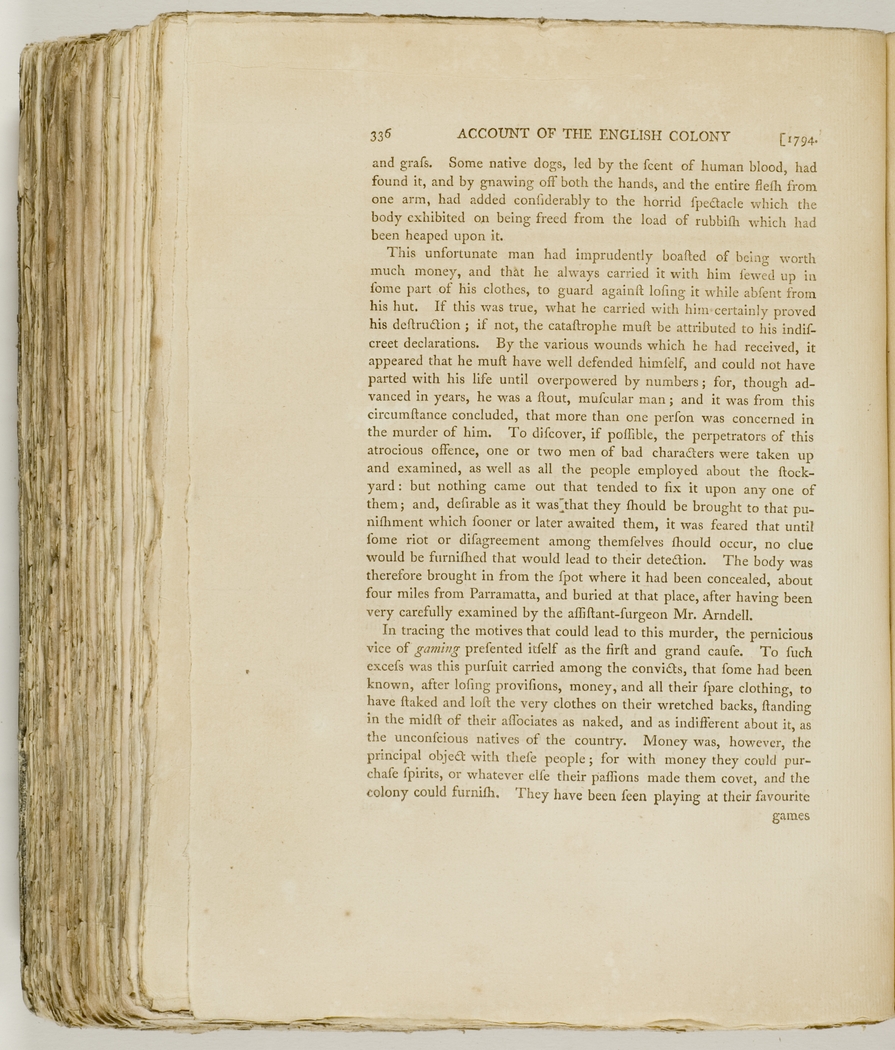The Dictionary of Sydney was archived in 2021.
Sydney’s Oldest Unsolved Murders
 An account of the English colony in New South Wales : with remarks on the dispositions, customs, manners, &c. of the native inhabitants of that country, compiled, by permission, from the MSS. of Lieutenant-Governor King by David Collins, London: 1798-1802, courtesy Dixson Library, State Library of NSW (Q79/60 v. 1, p335)
An account of the English colony in New South Wales : with remarks on the dispositions, customs, manners, &c. of the native inhabitants of that country, compiled, by permission, from the MSS. of Lieutenant-Governor King by David Collins, London: 1798-1802, courtesy Dixson Library, State Library of NSW (Q79/60 v. 1, p335)
Listen to Rachel and Tess on 2SER here
In November 1788, a soldier met an untimely, non-work related end when he ‘died at the hospital of the bruises he received in fighting with one of his comrades, who was, with three others, taken into custody and afterward tried upon a charge of murder’. The men responsible for the unexpected death would, however, be found guilty of manslaughter and not murder with ‘each sentenced to receive two hundred lashes’. So, while violence was not uncommon, murder was a relatively rare act and not all of the murders committed in colonial Sydney were solved. Some people just disappeared. It’s possible a murder was committed in late 1788 when a soldier suddenly went missing. There was another case of a missing person in April 1793, just over five years after the First Fleet arrived. David Collins recording that some people: … were taken up at Parramatta on suspicion of having murdered one of the watchmen belonging to that settlement; the circumstances of which affair one of them had been overheard relating to a fellow-convict, while both were under confinement for some other offence. A watchman certainly had been missing for some time past; but after much inquiry and investigation nothing appeared that could furnish matter for a criminal prosecution against them. The first convict in the colony believed to have been a victim of murder, dying at the hands of his fellow colonists, was John Lewis in January 1794. An enthusiastic gambler, Lewis regularly boasted of how he kept his illicit earnings stitched within his clothing. Again, the event is noted by David Collins who wrote that: … an elderly convict, employed to go out with the cattle at Parramatta, was most barbarously murdered. … [The body was found] … covered with logs, boughs, and grass. Some native dogs, led by the scent of human blood, had found it, and by gnawing off both the hands, and the entire flesh from one arm, had added considerably to the horrid spectacle which the body exhibited … Some brief inquiries were made in an attempt to identify those who were responsible for the incredibly violent crime but it was decided by authorities that the case would not be solved unless one of those responsible gave themselves or one of their gang members up. An account of the English colony in New South Wales : with remarks on the dispositions, customs, manners, &c. of the native inhabitants of that country, compiled, by permission, from the MSS. of Lieutenant-Governor King by David Collins, London: 1798-1802, courtesy Dixson Library, State Library of NSW (Q79/60 v. 1, p336)
An account of the English colony in New South Wales : with remarks on the dispositions, customs, manners, &c. of the native inhabitants of that country, compiled, by permission, from the MSS. of Lieutenant-Governor King by David Collins, London: 1798-1802, courtesy Dixson Library, State Library of NSW (Q79/60 v. 1, p336)

Categories
Blog
2SER Breakfast
convicts
crime
David Collins
early colony
John Burn
Joseph Luker
murder
mystery
Rachel Franks
sydney history
Tess Connery
unsolved

